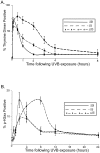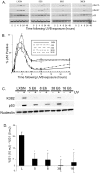HPV 5 and 8 E6 abrogate ATR activity resulting in increased persistence of UVB induced DNA damage
- PMID: 22807682
- PMCID: PMC3395675
- DOI: 10.1371/journal.ppat.1002807
HPV 5 and 8 E6 abrogate ATR activity resulting in increased persistence of UVB induced DNA damage
Abstract
The role of the E6 oncoprotein from high-risk members of the α human papillomavirus genus in anogenital cancer has been well established. However, far less is known about the E6 protein from the β human papillomavirus genus (β-HPVs). Some β-HPVs potentially play a role in non-melanoma skin cancer development, although they are not required for tumor maintenance. Instead, they may act as a co-factor that enhances the carcinogenic potential of UV damage. Indeed, the E6 protein from certain β-HPVs (HPV 5 and 8) promotes the degradation of p300, a histone acetyl transferase involved in UV damage repair. Here, we show that the expression of HPV 5 and 8 E6 increases thymine dimer persistence as well as the likelihood of a UVB induced double strand break (DSB). Importantly, we provide a mechanism for the increased DNA damage by showing that both extended thymine dimer persistence as well as elevated DSB levels are dependent on the ability of HPV 8 E6 to promote p300 degradation. We further demonstrate that HPV 5 and 8 E6 expression reduces the mRNA and protein levels of ATR, a PI3 kinase family member that plays a key role in UV damage signaling, but that these levels remain unperturbed in cells expressing a mutated HPV 8 E6 incapable of promoting p300 degradation. We confirm that the degradation of p300 leads to a reduction in ATR protein levels, by showing that ATR levels rebound when a p300 mutant resistant to HPV 8 mediated degradation and HPV 8 E6 are co-transfected. Conversely, we show that ATR protein levels are reduced when p300 is targeted for degradation by siRNA. Moreover, we show the reduced ATR levels in HPV 5 and 8 E6 expressing cells results in delayed ATR activation and an attenuated ability of cells to phosphorylate, and as a result accumulate, p53 in response to UVB exposure, leading to significantly reduced cell cycle arrest. In conclusion, these data demonstrate that β-HPV E6 expression can enhance the carcinogenic potential of UVB exposure by promoting p300 degradation, resulting in a reduction in ATR levels, which leads to increased thymine dimer persistence and increased UVB induced DSBs.
Conflict of interest statement
The authors have declared that no competing interests exist.
Figures








Similar articles
-
Beta-Genus Human Papillomavirus 8 E6 Destabilizes the Host Genome by Promoting p300 Degradation.Viruses. 2021 Aug 21;13(8):1662. doi: 10.3390/v13081662. Viruses. 2021. PMID: 34452526 Free PMC article. Review.
-
β-HPV 5 and 8 E6 disrupt homology dependent double strand break repair by attenuating BRCA1 and BRCA2 expression and foci formation.PLoS Pathog. 2015 Mar 24;11(3):e1004687. doi: 10.1371/journal.ppat.1004687. eCollection 2015 Mar. PLoS Pathog. 2015. PMID: 25803638 Free PMC article.
-
HPV 5 and 8 E6 expression reduces ATM protein levels and attenuates LINE-1 retrotransposition.Virology. 2013 Aug 15;443(1):69-79. doi: 10.1016/j.virol.2013.04.022. Epub 2013 May 23. Virology. 2013. PMID: 23706308 Free PMC article.
-
Beta human papillomavirus E6 expression inhibits stabilization of p53 and increases tolerance of genomic instability.J Virol. 2014 Jun;88(11):6112-27. doi: 10.1128/JVI.03808-13. Epub 2014 Mar 19. J Virol. 2014. PMID: 24648447 Free PMC article.
-
Loss of Genome Fidelity: Beta HPVs and the DNA Damage Response.Front Microbiol. 2017 Nov 15;8:2250. doi: 10.3389/fmicb.2017.02250. eCollection 2017. Front Microbiol. 2017. PMID: 29187845 Free PMC article. Review.
Cited by
-
H3.1K27me1 loss confers Arabidopsis resistance to Geminivirus by sequestering DNA repair proteins onto host genome.Nat Commun. 2023 Nov 18;14(1):7484. doi: 10.1038/s41467-023-43311-1. Nat Commun. 2023. PMID: 37980416 Free PMC article.
-
Epidemiology and biology of cutaneous human papillomavirus.Clinics (Sao Paulo). 2018 Aug 20;73(suppl 1):e489s. doi: 10.6061/clinics/2018/e489s. Clinics (Sao Paulo). 2018. PMID: 30133564 Free PMC article. Review.
-
Beta-Genus Human Papillomavirus 8 E6 Destabilizes the Host Genome by Promoting p300 Degradation.Viruses. 2021 Aug 21;13(8):1662. doi: 10.3390/v13081662. Viruses. 2021. PMID: 34452526 Free PMC article. Review.
-
Identification of C/EBPα as a novel target of the HPV8 E6 protein regulating miR-203 in human keratinocytes.PLoS Pathog. 2017 Jun 22;13(6):e1006406. doi: 10.1371/journal.ppat.1006406. eCollection 2017 Jun. PLoS Pathog. 2017. PMID: 28640877 Free PMC article.
-
The interplay of UV and cutaneous papillomavirus infection in skin cancer development.PLoS Pathog. 2017 Nov 30;13(11):e1006723. doi: 10.1371/journal.ppat.1006723. eCollection 2017 Nov. PLoS Pathog. 2017. PMID: 29190285 Free PMC article.
References
-
- zur Hausen H. Papillomaviruses in human cancers. Proc Assoc Am Physicians. 1999;111:581–587. - PubMed
-
- Cogliano V, Baan R, Straif K, Grosse Y, Secretan B, et al. Carcinogenicity of human papillomaviruses. Lancet Oncol. 2005;6:204. - PubMed
-
- Lorincz AT, Reid R, Jenson AB, Greenberg MD, Lancaster W, et al. Human papillomavirus infection of the cervix: relative risk associations of 15 common anogenital types. Obstet Gynecol. 1992;79:328–337. - PubMed
-
- Bouwes Bavinck JN, Feltkamp M, Struijk L, ter Schegget J. Human papillomavirus infection and skin cancer risk in organ transplant recipients. J Investig Dermatol Symp Proc. 2001;6:207–211. - PubMed
Publication types
MeSH terms
Substances
Grants and funding
LinkOut - more resources
Full Text Sources
Molecular Biology Databases
Research Materials
Miscellaneous

